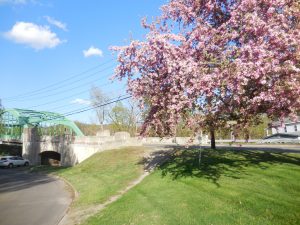HUNTINGTON – About a dozen community leaders in Huntington went on a “walk audit” of the town Tuesday afternoon, with the help of WalkBoston’s Stacey Beuttell and Healthy Hampshire’s Sarach C. Bankert. Bankert, whose organization recently donated a grant of $4,500 to create a riverwalk behind the town hall, invited Beuttell to the town to share her expertise.

Stacey Beuttell of WalkBoston gave a presentation prior to the “walk audit” of Huntington. (Photo by Amy Porter)
WalkBoston is a non-profit pedestrian advocacy organization dedicated to improving walking conditions in cities and towns across Massachusetts. Beuttell, an urban planner, has been focusing her efforts on the cities and hilltowns of western Massachusetts lately, conducting walk audits in Belchertown, Williamsburg, Northampton and in two weeks, the town of Goshen.
Beuttell said the walks are a brainstorming process, with an eye to what works when walking through a village or town, and what would make it more inviting for people to stop. She said walkability might mean trails and sidewalks, being able to park the car and visit several destinations, and being safe from traffic. She said walkability also includes well-marked crosswalks, and well-lit streets.
Beuttell acknowledged that in rural communities, walkability looks different than in urban communities. It could mean hiking and multi-use trails, road shoulders and roadside paths. She said another common issue in rural towns is road crossings, and how to slow down traffic going through rural villages. Route 20 goes directly through the town of Huntington, and slowing cars and trucks is an issue.
Beuttell shared a statistic that when a pedestrian is hit by a car going 20 mph, nine out of ten will survive. At 30 mph, five pedestrians out of five will survive. The number goes down to a one in ten survival rate for a pedestrian hit by a car traveling at 40 mph.
Beuttell said some of the things towns can do to slow traffic going through the center of town are curb extensions at crosswalks which don’t allow parking, and give the pedestrian a better view of oncoming traffic. She said even pedestrian crossing signs in a crosswalk are more visible, and can slow traffic, although they are often hit or taken.
Jeff Penn, a Huntington architect working with Healthy Hampshire to create the riverwalk, asked Beuttell whether Massachusetts allows for different types of crosswalks. Beuttell said many cities and towns have adopted their own crosswalk standards, which may include raised platforms or colorful designs, the more visible the better, she said.

A well-worn footpath from the Green Bridge to Town Hall is just 20 feet in front of concrete steps from the bridge that nobody uses. (Photo by Amy Porter)
During the walk audit, several different attributes of the town were discussed. The “Green Bridge” that connects Route 20 to Route 112, for example, has concrete steps that lead down to the back of town hall, that nobody uses. Instead, a well-worn path leads to the commons in front on Route 20. Beuttell suggested a sign on the steps, along with some repair walk, pointing people to the Riverwalk behind town hall.
The new sidewalks on the other side of the bridge at Pleasant and Basket Streets were considered a positive, especially the new curb extension in front of the former St. Thomas church. Selectman Ed Renauld said the extended curb slowed the cars down when they made the downhill turn onto Basket Street. Crosswalks, which are chalked off, will be going in at that intersection this year.

New sidewalks and a curb extension in front of St. Thomas church have slowed traffic turning onto Basket Street. (Photo by Stacey Beuttell)
Crossing Route 112 to the library, Renauld and selectman John McVeigh spoke about the idea of turning the lot of the former Murrayfield elementary school next door to the library into a multi-use park, with open space, chess tables for adults, and a playscape and basketball court for young people. The property also connects by a rough trail to Pettis Field below, where Little League is played.
Back at the town commons, the crosswalk across Route 20 was discussed as one that needs to be more visible. McVeigh took the pedestrian crossing sign that is used only during school pickups and drop-offs, and put it back in the center of the road.
Beuttell said she would get back to the group with her observations and suggestions for improvements in walkability in the town center. She said it might take a few weeks, however, being the height of “walk audit” season.


